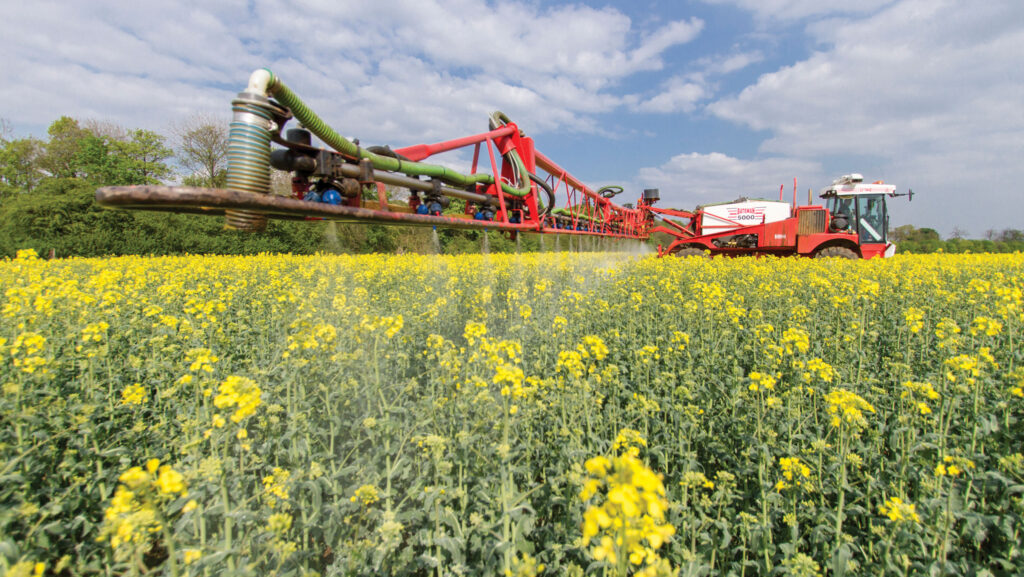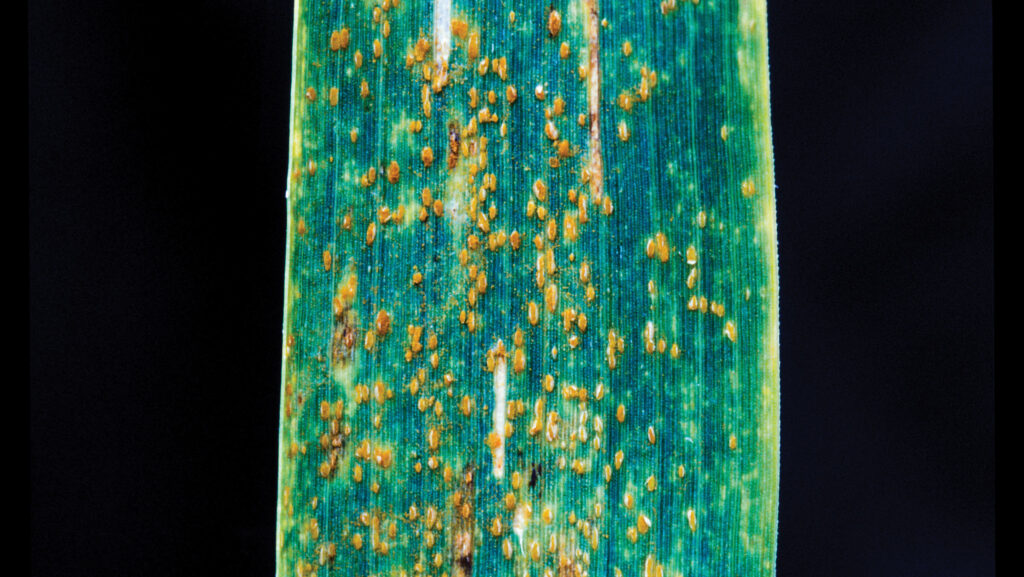Crop Watch: OSR flowering spray and T1s in forward wheat
 © GNP
© GNP The weather forecast is finally looking slightly better, but the damage is done and there is a huge backlog of field jobs.
Among these are flowering sprays in those oilseed rape crops that survived, and T1 fungicides, which are being applied to the more forward wheat crops in parts of the UK.
See also: Notts Monitor Farm sees benefits of reduced cultivations
West
Gavin Burrough
Pearce Seeds (Dorset/Hants/Wilts)
The local forecast has at last turned a lot more settled despite a few showers and high winds still on the weather radar, but hopefully, things are at last going in the right direction.
Winter wheat crops which were lucky enough to have received their second dose of nitrogen are by now growing away well and are rapidly approaching the T1 fungicide timing.
Some T0 fungicides have been applied, but a lot were not because of poor spraying conditions. This will make a timely T1 application essential as there is plenty of septoria to find, regardless of variety.
Leaf three can be found on these crops.
Wheat crops on wet or heavy ground are a different story.
Some have only just had their first dose of nitrogen applied to some very hungry crops, as ground conditions have not allowed vehicles to travel without the risk of getting stuck.
These wetter fields have only recently received their first grassweed herbicide for meadow grass, which means the next fungicide plus plant growth regulator timing will be pushed back to allow a long enough gap (seven days minimum) between the two applications.
Hopefully, these wheat crops can be nursed on to produce a sensible yield, as long as the weather plays ball.
Backwards crops
On the other hand, some of these backwards crops will be written off and replanted to something else as the winter crop is severely stunted and not tillered out. Choice of what to redrill will depend on individual situations.
Winter oat broad-leaved weed control will, hopefully, soon be completed before the crop starts growing away and its T1 fungicide plus PGR timings are reached.
The earlier drilled spring barley crops are now approaching leaf two or three stage.
Pre-emergence herbicides on spring barley have been missed this year mainly because of time restraints and less-than-ideal seed-beds, and the last thing we want to do is give the crop a headache if a pre-emergence herbicide application is soon followed by a rogue storm of heavy rain.
The plan will be to roll these fields as soon as the crops are strong enough and soil conditions allow.
Attention will soon turn to maize drilling. Like last year, I suspect crops will be drilled later than normal because other field work needs completing or just to wait for soil to dry out enough.
Maize is a very fussy crop and does not like to be forced into wet, cloddy seed-beds. Wait for the soil to warm up enough, 8-10C minimum for 4-5 consecutive days.
South
Alice Whitehead
Zantra (Essex/Kent)
All the signs of spring are here – orchards are in blossom, asparagus harvest is well under way, and winter cereal crops have turned a lovely shade of green after finally getting some nitrogen.
The only thing missing is some decent sunshine to get spring drillings up and away and let the winter crops start to recover after such difficult growing conditions so far.
T1 recommendations have been written and will be starting to be applied. I have opted for Solatenol (benzovindiflupyr) products, making sure to include an azole in the mix to back up activity on septoria and eyespot.
I also like using azoxystrobin at the T1 and T2 slots on crops intended for milling, as our trial work has shown an uplift in protein content, in combination with the appropriate rate of nitrogen.
Winter hybrid barley that was drilled in good time looks strong, with canopy management crucial. Ethephon has been utilised in conjunction with chlormequat at T1 to control lodging.
Barley that was drilled in mid-October is looking like the poorer cousin and is yet to look as promising.
Spring cereals
Spring cereals are a varied bunch, with some drilled in February and some only last week. Fungicide applications and the care of these crops will be a long, drawn-out affair.
Thanks to the mild weather, oilseed rape has been in flower for some time. Crops have received two fungicides so far this spring, with these warm and wet conditions spelling danger from sclerotinia.
We may be tempted to apply a third fungicide (tebuconazole + prothioconazole) in the next couple of weeks. The last thing we want is to fall at the final hurdle, with so much already invested in this crop. Mealy aphid can be found at low levels, which will be monitored.
Combining peas have been drilled and have received a pre-emergence herbicide. I have taken advantage of the new approval for aclonifen, combined with pendimethalin.
Cleavers and mayweed in winter beans are being cleared up with bentazone. Remember that warm, sunny conditions at application will help with the activity of this herbicide, and six hours drying time is required.
North
Patrick Stephenson
AICC (Yorkshire)
Like a child before Christmas, the excitement is palpable as the so-called weather forecast indicates three dry days in a row. Every part of the UK has sadly suffered, and the scenes of sodden fields make for a gloomy outlook.
The early drilled winter wheat crops are now approaching growth stage 31, and most have had at least one dose of nitrogen. The weather-induced lack of activity is creating a headache for our clients and us.
Although autumn-applied herbicide programmes have worked well, there is still an element of tidying up. This is coupled with the need to treat those crops which received no autumn herbicide applications.
Unfortunately, time is not on our side as the weeds get bigger and the label cutoff time draws ever closer. To make matters worse, tank mix opportunities with these sprays are limited.
Wheat disease
Septoria levels are huge in these forward crops, but as last year taught us, the following weather will dictate if this year will see an epidemic of disease.
Any bright ideas I had of a T0 for the yellow rust-prone varieties have long since passed, along with the split-rate growth regulator.
I anticipate that the forward crops will have leaf three fully emerged around 23 April and it looks as though there could be some very tasty tank mixes as we treat weeds, growth regulation, disease and manganese as required.
It is quite ironic that the poor crops, which are numerous out there, are the easiest to plan a T1. My economic Yorkshire mind sees that these fields can at best only justify a prothioconazole plus another value partner depending on the main risk, either septoria or rust.
I think crops drilled from January onwards also could have this value combination. The good crops out there could justify further investment, and there is a range of better chemistry available.
Winter barley
Winter barley crops are at growth stage 32 and the first flag leaves can be found. Growth regulators have only just been applied so the follow-up late growth regulator may not happen.
With generic versions of prothioconazole offering excellent value, I will be attempting some alchemy in the barley programmes with a range of mixtures.
Although I’m an advocate of three fungicide applications in barley, that plan has already gone and two will be the norm, using some SDHI within the programme.
The early drilled spring barleys are now through and will have the rest of their nitrogen applied as soon as conditions allow. I will not apply pre-emergence products to the late drilled crops as I fear any crop check that might occur would not be good.
Pigeons refuse to leave oilseed rape crops alone; they are limping into flower, and many are a sorry sight.
I will recommend a broad-spectrum fungicide at full flowering, and, in my opinion, it will at least cover the cost and in most years produce a profit.
Unfortunately, the addition of insecticides I find much harder to justify, and these will be added only in very specific circumstances.
The jury is still out on how much OSR will be drilled next year, but I fear that for many the grim reaper has arrived for this crop.
East
Ryan Baker
Frontier (Suffolk/Norfolk)
It seems to have been a long time coming, but spring work has now started to progress well between the April showers. The backlog of jobs has started to decrease.
Light-land spring cereals are now emerging and patience has paid off on the heavy land, where seed-beds are far better than expected. The drier and settled spell has allowed sugar beet drilling to commence.
First aphid flight was forecast for 10 April, but very little beet had emerged at that time. It is important to remember that all registered insecticides in sugar beet cannot be applied until two true leaves.
Winter barleys look very well, if not a little bit lush. Being drilled slightly earlier, they look to be the crop of the autumn. T1s have either gone on or are now being applied.
The disease mentioned last month has not gone away and the eradicant activity of the T1 has been crucial. Increasing day length means they are progressing through their growth stages at a rapid rate and thoughts will soon turn to growth regulation before awn emergence, especially in hybrid varieties.
Oilseed rape
The mid-flower timing for sclerotinia protection has occurred slightly earlier this year, but the flowering duration is currently very protracted, so keep an eye out on the AHDB’s sclerotinia forecast. Sclerotinia infection requires 23 hours of air temperatures above 7C and 80% relative humidity.
A preventative approach, before significant petal fall, is best. This is also the time to consider cabbage seed weevil; the threshold in the south is one weevil per plant.
Winter wheat has a large amount of septoria present on lower leaves. Mild and wet weather has counteracted any expected reduction in disease pressure from later drilled crops.
Yellow rust has also reared its head in susceptible varieties such as Insitor, Skyfall and Zyatt. It is also easy to find in Extase.

Brown rust on wheat © Blackthorn Arable
Brown rust has already been reported in Crusoe. A strong T1 is going to pay dividends in keeping the crop as clean as possible from the outset.
The launch of Vimoy (isoflucypram) has provided a fantastic broad-spectrum option for T1. However, the variability of crops requires the matching of programmes to the yield potential.
Accurate timing in variable crops is challenging. The majority of plants should have 60-70% of leaf three emerged.
Following on from Vimoy, the recent registration of Miravis Plus (pydiflumetofen) will provide more options for T2 this season.

